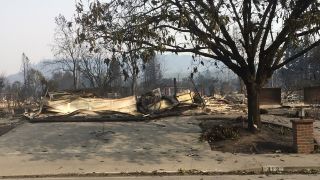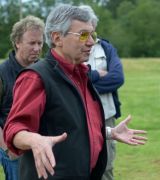Thanks to my work in the field, I found that in an unspoiled natural environment, animals communicate with each other in the same way as players of musical instruments in an orchestra. Especially on land, the subtle acoustic texture is almost as well defined when you graphically represent it as notes in a score using “vocal tracks.”
Bernie Krause, The Loss of Natural Soundscapes, Earth Island.org Journal, 2002
When I first wandered into a forest with a recorder and a pair of microphones, in 1968, I was scared to death and literally clueless about how to listen and capture the sounds of the woods. I was on a blind mission — initially drawn there to hear and capture natural ambiences to include as part of an orchestration for an electronic music album and, in the process, find a location that produced something other than the din of human noise. There were no clearly defined goals. No mentors. No teaching guides. Protocols for taping whole natural habitats, whether on land or under the sea, were virtually unknown. Conceptual ways of perceiving and expressing most aspects of field recording were nonexistent, let alone the language for describing the phenomena revealed through sound. Humans had yet to realize the numinous epiphanies that would clarify the associations between the sounds produced by nonhuman organisms and our diverse cultures.
For most of us, the acoustic world has always been an elusive one — an indistinct amorphic entity, unseeable and intangible — and listening is the “shadow sense.” Outside of musical literature, few words in English exist to explain the vast range of attributes that sounds express, especially in the emerging world of bioacoustics, the study of the sounds produced by living animals.
In the late 1970s, the Canadian composer and naturalist R. Murray Schafer coined the word soundscape to refer to the multiple sources of sounds that reach the human ear. Combining this with the word ecology, I use the resulting term, soundscape ecology, to describe new ways of evaluating the living landscapes and marine environments of the world, mostly through their collective voices.
In order to be heard in urban, rural, or wild habitats, vocal organisms must find acoustic niches where their utterances are not buried by other signals.
The soundscape concept consists of what I call signature sources, meaning that each type of sound, from whatever origin, contains its own unique signature, or quality, one that inherently contains vast stores of information. That individual signature is unlike any other. So, also, is the natural soundscape unique in its collective state, especially as it becomes the voice of an entire habitat.
With my colleague Stuart Gage from Michigan State University, I have introduced new language meant to describe the three primary acoustic sources that make up a typical soundscape. The first is geophony, the nonbiological natural sounds produced in any given habitat, like wind in the trees or grasses, water in a stream, waves at the ocean shore, or movement of the earth. The second is biophony, the collective sound produced by all living organisms that reside in a particular biome. And last is anthropophony, or all of the sounds we humans generate. Some of these sounds are controlled, like music, language, or theater. But most of what humans produce is chaotic or incoherent — sometimes referred to as noise.
It is important to keep in mind the substantial impact each of these components may have on one another and how they interrelate.
Surrounding our home in rural northern California, the sounds my wife, Katherine, and I have come to know consist of year-round aural traceries of birds, squirrels, amphibians, and insects in the mid-field, the personal conversations we share or the pleading voices of our cats, Barnacle and Seaweed, to be fed or released from indoor bondage to the wider world, the chatter of the TV or the whispered hum of the refrigerator compressor heard from the near field, and the sometimes irritating intrusion of commercial and light aircraft flying overhead combined with the far-off hushed drone of vehicular traffic from two miles away in the far field. The daily and seasonal sounds that define Wild Sanctuary, our home, convey a unique sense of place, one we’ve come to know as much by listening as by seeing.
The phenomenon of the soundscape usually consists of signals arriving from all directions on the horizontal plane and vertically from the sources overhead — a dome of 3D sound and combinations of any or all of the three main sources mentioned earlier. Whether we’re conscious of them or not, we’re completely surrounded by acoustic elements coming at us from all directions. Active signals generally consist of biophonies and anthropophonies. Passive elements, such as wind and other weather-related signals, make up the rest. The impact of these sounds can be quite pervasive, depending on the environment. Sound, pressure waves transmitted through the air from a source to some type of receiver, can define the boundaries and structural properties of a room, a particular landscape. The soundscape not only reveals the presence of vocal organisms that inhabit wild biomes, but defines the acoustic detail of floral and geographical features — think of the effects of wind in the trees or grasses, or water flowing in streams and by the lake or seashore. Soundscapes also expose the imbalance sometimes caused by changes in the landscape due to human endeavor or natural causes such as invasive organisms, weather, or movement of the land. One of my lifelong interests has been to find new ways to read, comprehend, and express these sources of information.
Schafer’s idea of the soundscape defines events as all the audio signals that reach our ears at any given time. The same goes for the acoustic receptors of nonhuman creatures. With the introduction of new descriptive language, such as geophony, biophony, and anthropophony, I was able to flesh out in greater detail the basic sources of sound. We have now cleared a path for a range of understanding in both science and culture that leads to fresh ways of experiencing and understanding the living world.
One of the most thrilling aspects of my work has been the discovery of the niche hypothesis, an early stage of the biophony concept — the collective and structured sound that whole groups of living organisms generate in a biome at any given moment. The term, originally proposed by my colleague Ruth Happel, became clear between 1983 and 1989 and led to the observation that the makeup of wild soundscapes was primarily a form of expression where each type of organism evolved to vocalize within a specific bandwidth — based on either frequency or time. That, in turn, shed light on the bioacoustic relationships between all of the organisms present in a particular biome. In other words, in order to be heard, whether in urban, rural, or wild habitats, vocal organisms must find appropriate temporal or acoustic niches where their utterances are not buried by other signals.
More recently, we have begun to explore the interactions between biophony and the other sources of sound: geophony and anthropophony. For example, several studies, particularly those in process by Nadia Pieretti at Italy’s Urbino University, have shown that birds alter their vocalizations to accommodate themselves to urban noise. And killer whales (Orcinus orca) do the same with boat noise in their marine environments. Other studies have led to the observation that the music and language produced by a few remaining indigenous cultures can be directly tied to the intricate soundscapes of the natural world that defined their respective habitats, in a rare instance of human biophonic expression.
Gary Snyder, the American eco-poet elder, has pointed out that human language is wild, organizing and reorganizing itself independently of human will. My efforts have shown that, in much the same way, the communicative structures in certain undisturbed biomes form a basis for that paradigm, a constantly changing, reflexive synthesis of correlated sound and its subsequent harvest. Our current understanding of the natural world soundscape necessarily pinpoints “acoustic niches,” the special ways different species in a single soundscape use to jostle for sonic territory. By recognizing the function of this partitioning, or formation of acoustic and temporal niches, a creative and important realization emerges: that soundscape ecology is no less crucial than spatial or landscape ecology for our understanding of ecosystem function. Animal communication turns out to be as significant a factor in defining material or acoustic real estate, habitat, and ecological integrity as, say, trophic structure — the feeding and nourishment relationships of all organisms in a specific environment. In fact, territory, habitat, and ecological integrity may no longer be broadly definable in three spatial dimensions alone. The addition of soundscape ecology adds a fourth.
With our cultural focus primarily on visual experience and manifestation, we seem to have lost the delicate balance informed by incorporating all of the senses in our awareness of place. Nevertheless, it is imperative that we engage with wildness through its multiple dimensions. In that way, our inclusion of the holistic acoustic model enlarges our sense of the wild by literally expanding the boundaries of perception. It also rivets us to the present tense — to life as it is — singing in its full-throated choral voice and where each singer is expressing its particular song of being. It is my goal to encourage us to take a deeper plunge into a wilder world beyond the mundane and merely visual, suggesting that the natural wild is both more complex and more compelling than meets the simple eye. As I always remind my students, “A picture may be worth a thousand words, but a natural soundscape is worth a thousand pictures.”
This article was adapted from the book Voices of the Wild published by Yale University Press, with the kind permission by Bernie Krause. © 2015.



